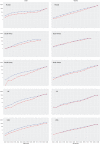Sex differences in coronary heart disease and stroke mortality: a global assessment of the effect of ageing between 1980 and 2010
- PMID: 28589033
- PMCID: PMC5435266
- DOI: 10.1136/bmjgh-2017-000298
Sex differences in coronary heart disease and stroke mortality: a global assessment of the effect of ageing between 1980 and 2010
Abstract
Background: Cardiovascular disease mortality rates are well known to be lower in women than men and to increase with age. Whether these sex and age effects have changed over recent decades, and how much they differ by country, is unclear.
Method: From the WHO Mortality Database, we obtained age-specific and sex-specific coronary heart disease (CHD) and stroke mortality rates for the world's most populous countries with data available between 1980 and 2010. We calculated age-specific, country-specific and period-specific men-to-women CHD and stroke mortality rate ratios for 26 countries and compared the differences between and within countries over time.
Results: CHD and stroke mortality decreased substantially between 1980 and 2010 in most countries, in both sexes. Mostly there was an attenuation of the effect of ageing over calendar time, more so in men than in women. CHD mortality was higher in men than in women throughout adulthood, but the magnitude of the difference varied by age. Men-to-women CHD mortality rate ratios were 4-5 in middle age (30-64 years) and 2 thereafter (65-89 years). Stroke mortality was more similar between sexes, with men-to-women stroke mortality rate ratios of around 1.5-2 until old age.
Conclusions: While CHD and stroke mortality rates declined considerably between 1980 and 2010 in both sexes, there was some indication for stronger age-specific reductions in CHD in men than women. Mortality from CHD and stroke remains higher among men than women until old age across a range of economically, socially and culturally diverse countries.
Conflict of interest statement
Competing interests: None declared.
Figures





References
-
- The Global Burden of Disease 2013 Mortality and Causes of Death Collaborators. Global, regional, and national age-sex specific all-cause and cause-specific mortality for 240 causes of death, 1990–2013: a systematic analysis for the Global Burden of Disease Study 2013. Lancet 2015;385:117–71. 10.1016/S0140-6736(14)61682-2 - DOI - PMC - PubMed
-
- The Global Burden of Disease 2013. http://vizhub.healthdata.org/gbd-compare/#. (Accessed 18-08-2016).
Grants and funding
LinkOut - more resources
Full Text Sources
Other Literature Sources
